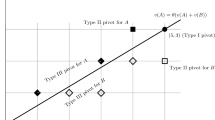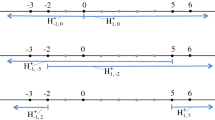Abstract
We consider a problem in which a policy is chosen from a one-dimensional set over which voters have single-peaked preferences. While Moulin (Public Choice 35:437–455, 1980) and others subsequent works have focused on strategy-proof rules, Renault and Trannoy (Mimeo 2011) and Renault and Trannoy (J Pub Econ Theory 7:169–199, 2005) have shown that the average rule implements a generalized median rule in Nash equilibria and provide an interpretation of the parameters in Moulin’s rule. In this article, we first extend their result by showing that a wide range of voting rules which includes the average rule can implement Moulin’s rule in Nash equilibria. Moreover, we show additionally that within this class, generalized average rules are Cournot stable. That is, from any strategy profile, any best response path must converge to a Nash equilibrium.
Similar content being viewed by others
References
Abreu D, Matsushima H (1992) Virtual implementation in iteratively undominated strategies: complete information. Econometrica 60: 993–1008
Abreu D, Sen A (1991) Virtual implementation in Nash equilibrium. Econometrica 59: 997–1021
Attiyeh G, Franciosi R, Isaac RM (2000) Experiments with the pivotal process for providing public goods. Public Choice 102: 95–114
Barbera S (2001) An introduction to strategy-proof social choice functions. Soc Choice Welf 18: 619–653
Barbera S, Gul F, Sonnenschein H (1994) Generalized median voter schemes and committees. J Econ Theory 61: 262–289
Bernheim BD, Peleg B, Whinston MD (1987) Coalition-proof Nash equilibria I: concepts. J Econ Theory 42: 1–12
Black D (1948) On the rationale of group decision-making. J Polit Econ 56: 23–34
Bochet O, Saijo T, Sakai T, Yamamura H, Yamato T (2008) Manipulation of preferences in rationing problems: experimental evidence. Mimeo
Bochet O, Sakai T (2010) Secure implementation in allotment economies. Games Econ Behav 68: 35–49
Bochet O, Sakai T, Thomson W (2010) Preference manipulations lead to the uniform rule. Mimeo
Cason T, Saijo T, Sjöström T, Yamato T (2006) Secure implementation experiments: do strategy-proof mechanisms really work?. Games Econ Behav 57: 206–235
Ching S (1994) An alternative characterization of the uniform rule. Soc Choice Welf 40: 57–60
Ching S (1997) Strategy-proofness and “median voters”. Int J Game Theory 26: 473–490
Dubey P, Haimanko O, Zapechelnyuk A (2006) Strategic complements and substitutes, and potential games. Games Econ Behav 54: 77–94
Fujinaka Y, Sakai T (2007) The manipulability of fair solutions in assignment of indivisible goods with money. J Public Econ Theory 9: 993–1011
Gibbard A (1973) Manipulation of voting schemes: a general result. Econometrica 41: 587–601
Hurwicz L (1978) On the interaction between information and incentives in organization. In: Krippendorf K (ed) Communications and Interactions in Society. Scientific Publishers, New York
Jackson MO (2003) Optimization and operations research. In: Derigs U (ed) Optimization and operations research, in the encyclopedia of life support systems. EOLSS Publishers, Oxford
Jensen MK (2009) Stability of pure strategy Nash equilibrium in best-reply potential games. Working Paper, Department of Economics, University of Birmingham, Birmingham
Kawagoe T, Mori T (2001) Can the pivotal mechanism induce truth-telling? an experimental study. Public Choice 108: 331–354
Maskin E (1999) Nash equilibrium and welfare optimality. Rev Econ Stud 66: 23–38
Monderer D, Shapley LS (1996) Potential games. Games Econ Behav 14: 124–143
Moulin H (1980) On strategy-proofness and single-peakedness. Public Choice 35: 437–455
Otani Y, Sicilian J (1982) Equilibrium allocations of Walrasian preference games. J Econ Theory 27: 47–68
Renault R, Trannoy A (2011) Assessing the extent of strategic manipulation: the average vote example. SERIEs 2:497–515
Renault R, Trannoy A (2005) Protecting minorities through the average voting rule. J Pub Econ Theory 7: 169–199
Saijo T, Sjöström T, Yamato T (2007) Secure implementation. Theor Econ 2: 203–229
Sandholm W (2002) Evolutionary implementation and congestion pricing. Rev Econ Stud 69: 667–689
Sandholm W (2005) Negative externalities and evolutionary implementation. Rev Econ Stud 72: 885–915
Sandholm W (2007) Pigouvian pricing and stochastic evolutionary implementation. J Econ Theory 132: 367–382
Satterthwaite MA (1975) Strategy-proofness and Arrow’s conditions: existence and corresponding theorems for voting procedures and social welfare functions. J Econ Theory 10: 187–217
Sjöström T (1994) Implementation in undominated Nash equilibria without integer games. Games Econ Behav 6: 502–511
Sprumont Y (1991) The division problem with single-peaked preferneces: a characterization of the uniform allocation rule. Econometrica 59: 509–519
Sprumont Y (1995) Strategy-proof collective choice in economic and political environments. Can J Economics 28: 68–107
Tadenuma K, Thomson W (1995) Games of fair division. Games Econ Behav 9: 191–204
Trockel W (1999) Unique Nash implementation for a class of bargaining solutions. Int Game Theory Rev 1: 267–272
Voorneveld M (2000) Best-response potential games. Econ Lett 66: 289–295
Yamamura H (2011) On coalitional stability and single peakedness. RIEB discussion paper series no. 2011–21, Kobe University, Kobe
Author information
Authors and Affiliations
Corresponding author
Rights and permissions
About this article
Cite this article
Yamamura, H., Kawasaki, R. Generalized average rules as stable Nash mechanisms to implement generalized median rules. Soc Choice Welf 40, 815–832 (2013). https://doi.org/10.1007/s00355-011-0645-z
Received:
Accepted:
Published:
Issue Date:
DOI: https://doi.org/10.1007/s00355-011-0645-z




